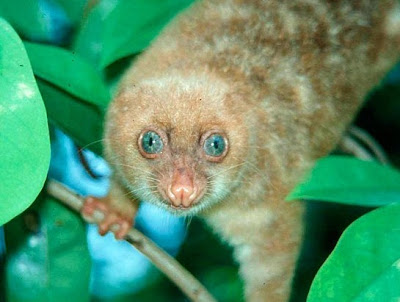 |
| A blue-hued Monitor lizard - Varanus Macraei. |
Scientists made the astounding discoveries, which included a river shark and dozens of butterflies, at a rate of two a week from 1998 to 2008, WWF said in a report on the island's natural habitat.
"This report shows that New Guinea's forests and rivers are among the richest and most biodiverse in the world," WWF Western Melanesia program representative Neil Stronach said.
PNG's rainforests are the third-biggest in the world after the Amazon and the Congo, and, while the island covers just 0.5 per cent of Earth's land mass, it contains up to 8 per cent of the world's species, according to WWF.
The 1060 species confirmed by scientists as new discoveries between 1998 and 2008 are believed to have only scratched the surface of PNG's dazzling ecosystems.
 |
| The round-headed dolphin - Orcaella Heinsohni. |
One of the most notable finds documented in the WWF report was a round-headed and snub-finned dolphin, which swims in protected, shallow coastal waters near rivers and creek mouths.
Discovered in 2005 in PNG, it was the first new dolphin species recorded anywhere in the world in three decades, and is now known to exist in Australia, WWF said.
Another of the 12 mammals found over the decade was an anteater named in honour of British naturalist David Attenborough, Sir David's long-beaked echidna or, scientifically, Zaglossus attenboroughi.
One of the 134 frogs discovered was dubbed Litoria sauroni because its striking red and black spotted eyes reminded scientists of the evil character Sauron in the Lord of the Rings movies.
 |
| A large green tree frog - Litoria dux. |
Nine snail species were among the 580 new invertebrates discovered.
Among the other new invertebrates was a brightly coloured apricot crayfish, part of the yabby family, which was 9-12cm long.
Discoveries of new fish totalled 71, with a kaleidoscope of colours, including one in the coral reefs of Milne Bay that thrilled scientists with its dazzling blue hue.
WWF said the most extraordinary freshwater discovery was a 2.5m river shark found in PNG that has since also been located in northern Australia.
Of the 43 reptiles discovered, one could claim to be the most innocuous snake in the world. It was just 12-14cm long, could not bite, had no venom and had scales over its eyes so it could not see.
 |
| A blue-eyed spotted Cuscus - Spilocuscus Wilsoni. |
as in the Amazon and Borneo rainforests, human actions were destroying Papua New Guinea's natural habitat at an "alarming rate".
New Guinea is the largest tropical island on Earth and is divided between the countries of Papua New Guinea (PNG) in the East and Indonesia in the West. It contains the third largest tract of rainforest in the world after the Amazon and the Congo. The island covers less than 0.5 per cent of the Earth’s landmass but shelters 6 to 8 per cent of the world’s species. An estimated two-thirds of these species are unique to New Guinea.
“If you look at New Guinea in terms of biological diversity, it is much more like a continent than an island,” says Dr. Stronach. “Scientists found an average of two new species each week from 1998 – 2008 – something nearly unheard of in this day and age,” he says.
“Despite its remote location, New Guinea’s natural habitats are being lost at an alarming rate. The island’s forests are facing serious threats including logging, mining, wildlife trade and conversion to agriculture, particularly oil palm,” said Dr Susanne Schmitt, New Guinea Programme Manager at WWF-UK. “As a region with high rates of poverty, it is absolutely essential that New Guinea’s precious reefs, rainforests, and wetlands are not plundered but managed sustainably for future generations”.
In PNG between 1972 and 2002, independent studies have shown that 24 per cent of rainforests were cleared or degraded through logging or subsistence agriculture. Increasingly, demand for palm oil is also destroying many of New Guinea’s most valuable rainforests. Large forest areas on the island (and across the region) are being cleared for oil palm monocultures, destroying critical habitat for many endangered species.
The destruction of these forests, which are usually cleared by burning, releases huge amounts of greenhouse gasses into the atmosphere and accelerates climate change. However, many oil palm producers in New Guinea and around the world are pursing certification through the Roundtable on Sustainable Palm Oil (RSPO. Certified Sustainable Palm Oil (CSPO) guarantees that social and environmental safeguards have been met during production. And importantly, CSPO also assures that high conservation value forests haven’t been cleared.
No comments:
Post a Comment